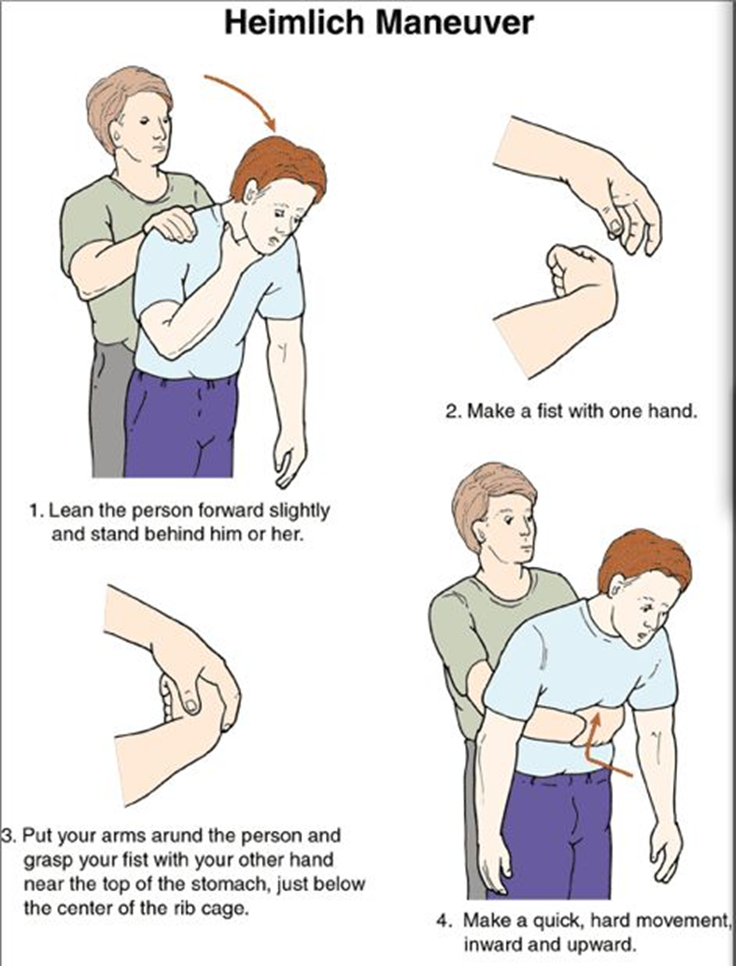A nurse is attending a social event when another guest coughs weakly once, grasps his throat with his hands, and cannot talk. Which of the following actions should the nurse take?
Perform the Heimlich maneuver.
Slap the client on the back several times.
Assist the client to the floor and begin mouth-to-mouth resuscitation.
Observe the client before taking further action.
The Correct Answer is A
Choice A reason:
The Heimlich maneuver, also known as abdominal thrusts, is the recommended first aid technique for a conscious person who is choking. This maneuver helps to expel the object blocking the airway by using the air remaining in the lungs to force it out. The nurse should stand behind the person, place their arms around the person’s waist, make a fist with one hand, and place it just above the navel. The other hand should grasp the fist, and quick, upward thrusts should be performed until the object is expelled.

Choice B reason:
Slapping the client on the back several times is not the recommended first action for a conscious adult who is choking. While back blows can be effective, they are typically used in combination with abdominal thrusts and are more commonly recommended for infants. For adults, the Heimlich maneuver is preferred as the initial response.
Choice C reason:
Assisting the client to the floor and beginning mouth-to-mouth resuscitation is not appropriate for a conscious person who is choking. Mouth-to-mouth resuscitation, or rescue breathing, is used when a person is not breathing and is unresponsive. In this scenario, the client is conscious but unable to speak, indicating a blocked airway that requires the Heimlich maneuver.
Choice D reason:
Observing the client before taking further action is not advisable in a choking emergency. Immediate intervention is crucial to prevent the situation from worsening. If the person is unable to speak, cough, or breathe, the Heimlich maneuver should be performed without delay.
Nursing Test Bank
Naxlex Comprehensive Predictor Exams
Related Questions
Correct Answer is []
Explanation
In this scenario, the client is most likely experiencing iron deficiency anemia, based on the diagnostic results that show low hemoglobin (10 mg/dL), low hematocrit (31%), and low serum ferritin (9 mcg/L), which are below the normal ranges for a pregnant individual.
The correct answers are:
Potential Condition:
- a. Iron deficiency anemia
Actions to Take:
- a. Administer iron supplements (to address the anemia and increase iron levels)
- b. Teach the client about a diet rich in iron (to support iron supplementation and improve dietary intake of iron)
Parameters to Monitor:
- a. Hemoglobin levels (to assess improvements in oxygen-carrying capacity and monitor for anemia)
- b. Hematocrit levels (to monitor the volume of red blood cells and further assess anemia)
By addressing the low iron levels, administering supplements, and providing dietary guidance, the nurse can help correct the anemia. Monitoring hemoglobin and hematocrit will help track the client’s progress in overcoming the condition.
Correct Answer is B
Explanation
Choice A Reason:
Vesicles on the skin are more commonly associated with cutaneous anthrax, not inhalation anthrax. Cutaneous anthrax typically presents with a raised, itchy bump that develops into a painless sore with a black center.
Choice B Reason:
Respiratory failure is a severe and common symptom of inhalation anthrax. Inhalation anthrax begins with flu-like symptoms but can rapidly progress to severe respiratory distress, shock, and often death if not treated promptly.
Choice C Reason:
Flu-like symptoms are indeed an early sign of inhalation anthrax, but they are not specific enough to indicate exposure definitively. These symptoms include sore throat, mild fever, fatigue, and muscle aches.
Choice D Reason:
Coughing of blood can occur in the later stages of inhalation anthrax as the disease progresses and the respiratory system becomes severely compromised.
Whether you are a student looking to ace your exams or a practicing nurse seeking to enhance your expertise , our nursing education contents will empower you with the confidence and competence to make a difference in the lives of patients and become a respected leader in the healthcare field.
Visit Naxlex, invest in your future and unlock endless possibilities with our unparalleled nursing education contents today
Report Wrong Answer on the Current Question
Do you disagree with the answer? If yes, what is your expected answer? Explain.
Kindly be descriptive with the issue you are facing.
